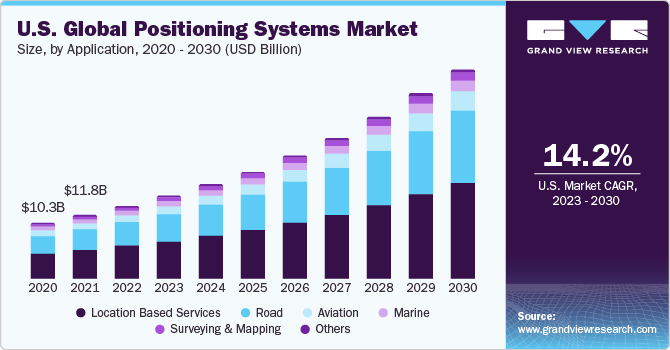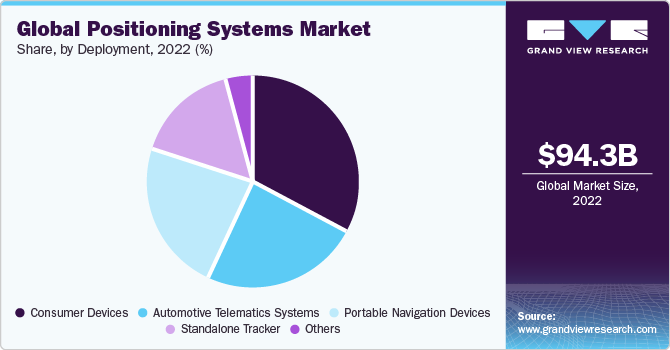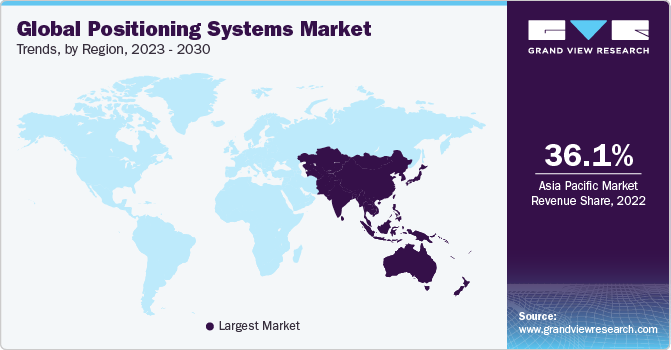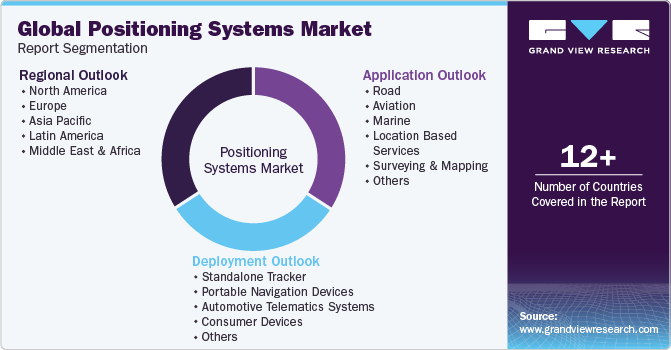- Home
- »
- Communications Infrastructure
- »
-
Global Positioning Systems Market Size & Share Report 2030GVR Report cover
![Global Positioning Systems Market Size, Share & Trends Report]()
Global Positioning Systems Market Size, Share & Trends Analysis Report By Deployment, By Application (Road, Aviation, Marine, Location-Based Services, Surveying & Mapping, Others), By Region, And Segment Forecasts, 2023 - 2030
- Report ID: GVR-2-68038-473-4
- Number of Report Pages: 161
- Format: PDF, Horizon Databook
- Historical Range: 2018 - 2021
- Forecast Period: 2023 - 2030
- Industry: Technology
Global Positioning Systems Market Trends
The global positioning systems market size was estimated at USD 94.25 billion in 2022. It is anticipated to grow at a compound annual growth rate (CAGR) of 16.1% from 2023 to 2030. The increasing penetration of smartphones and the proliferation of GPS-enabled vehicles are projected to bolster the market's growth during the forecast period. Moreover, the surging use of social media across developing countries and growth in mergers and acquisitions between component manufacturers and integrators are poised to stoke the growth of the global positioning systems market.

Over the years, the global positioning system has become a common tool used for navigation. The past couple of years have witnessed a rise in the use of GPS-enabled smartphones. The growing adoption of e-hailing services across the globe is further likely to escalate the demand for GPS-enabled smartphones. The system used in road applications provides various benefits to customers, including ease of traveling and accurate monitoring of operations and assets. Increasing smart mobility applications, such as navigation, fleet management, satellite road traffic monitoring, and several others, are expected to propel the market over the forecast period.
Prominent GPS component manufacturers such as Qualcomm Inc., Hexagon AB, Broadcom Inc., Trimble Navigation Limited, MiTAC Digital Technology Corporation (Navman), TomTom N.V, Rockwell Collins Inc., Texas Instruments Inc., Garmin Ltd., and Mio Technology Corporation are estimated to make significant investments in R&D activities. The strategy is anticipated to help them develop new innovative deployments, solutions, and augmented services, which will strengthen their position in the global arena.
Besides, mergers and acquisitions between component manufacturers and system integrators are expected to help GPS market players capture a high revenue share and increase overall profitability over the coming years. For instance, in March 2023, Topcon Positioning Systems acquired Digital Construction Works (DCW. With this acquisition, Topcon aims to leverage DCW's expertise in providing a platform that enables customers to effectively manage and optimize construction data across various applications and software. DCW's services and software integration platform will assist customers in efficiently navigating and maximizing the utilization of construction data, enhancing productivity, and streamlining workflows in the construction industry.
However, the need for more network infrastructure in underdeveloped areas and location accuracy are poised to restrict the market from realizing its utmost potential. Clock inaccuracy and orbit shift of satellites are anticipated to provide technical challenges to GPS usage. Licensing, strict rules, and regulations are also expected to be a significant barrier to rendering services efficiently.
Application Insights
GPS technology can be used in various applications, including road, aviation, marine, location-based services, surveying and mapping. The location-based services segment represented the leading share of 42.9% of the global positioning systems market in 2022. The growth can be attributed to a shift in consumer trends towards e-commerce and e-hailing services.
Mobile manufacturers and application developers are showing an increased interest in using location-based information as an enabler for several enterprises, customers, and public safety services. For instance, several enterprises also leverage location-based data for analytics and advertising applications that help enterprises understand consumer behavior and reach the target customers, thus aiding them in expanding their business. Location-based information can be useful for secure authentication of users and fraud management services while enabling mobile services.
Location technology plays a vital role in road applications, owing to which the road applications segment is anticipated to command a sizeable share of the overall value in 2022. In addition, with rising demand for inbuilt GPS modules in automobiles and surging demand for autonomous vehicles, key vehicle manufacturers are focusing on undertaking partnerships and agreements with component manufacturers.
The road application segment is witnessing growth in the global positioning market at the highest CAGR of 16.6%. The growth is attributed to increasing demand for accurate navigation, real-time traffic updates, and efficient routing services. Integration of GPS technology in road applications has improved transportation efficiency, enhanced safety, and enabled features like fleet management and smart city initiatives. The rise of connected vehicles, mobile mapping apps, and government support for road infrastructure further contribute to this growth.
Deployment Insights
The consumer devices segment accounted for the highest revenue share of 45.2% in 2022, owing to the proliferation of smartphones, tablets, and PCs worldwide. GPS technology is increasingly deployed in consumer devices such as smartphones and tablets. It is also used in other devices, such as automotive telematics, portable navigation, and standalone trackers.
Moreover, GPS technology is used to transmit fleet positioning information through onboard units (OBUs) to assist transport operators in monitoring logistics performance activities. An increasing number of connected vehicles and growing driving safety concerns are estimated to lead to significant growth in the automotive telematics systems segment during the forecast period.

Automotive telematics systems segment is anticipated to witness significant growth during the forecast period. It is attributed to increasing usage and dependence on GPS systems for real-time and accurate navigation. The growing usage of GPS among industries to track vehicles and manage fleets is also fueling the growth of this segment.
Regional Insights
North America, Europe, Asia Pacific, South America, and MEA (Middle East and Africa) are the key regions reviewed in the report. North America is one of the regions witnessing significant growth in the market. The growth is due to high military expenditure by governments (approximately 4.0% of the country’s GDP each year) and the high penetration of smartphones in the region. The penetration of smartphones in the region has been increasing, resulting in increased demand for location-based services. Thus, the regional market is expected to register a healthy growth rate during the forecast period.

Asia Pacific is leading the market, with a market share of 36.1% in 2022. The growth is attributed to rising smartphone users, growing broadband adoption, and high network infrastructure investments. Moreover, the widening base of social media users and an increasing number of GPS-enabled applications to share their real-time locations are likely to stimulate the growth of the regional market during the forecast period.
Key Companies & Market Share Insights
The key players in the industry are focusing on organic and inorganic growth strategies to maintain their market position. The industry players are undertaking strategies such as product launches, acquisitions, and collaborations to increase their global reach. For instance, in April 2023, Syntony GNSS, a prominent provider of SDR Positioning, Navigation, and Timing (PNT) solutions, integrated Xona Space Systems' LEO PNT constellation into its range of GNSS receiver and simulator solutions. This integration brings several advantages, including the advanced signal structure, utilization of high-power signals, and security techniques. These enhancements improve accuracy and resilience against challenges like spoofing, jamming, and multipath interference in complex RF environments. Syntony GNSS's collaboration with Xona Space Systems aims to deliver cutting-edge solutions for robust and reliable PNT applications.
Key Global Positioning Systems Companies:
- Hexagon AB
- Qualcomm Technologies, Inc.
- Broadcom
- Trimble Inc.
- MiTAC Holdings Corp
- TomTom International BV
- Collins Aerospace
- Texas Instruments Incorporated
- Garmin Ltd.
Recent Developments
-
In June 2023, Topcon Positioning Systems acquired Satel Oy, a renowned and pioneering company based in Salo, Finland. Satel specializes in wireless technology and is globally recognized as a leading expert. The company excels in designing, manufacturing, and providing top-notch connectivity solutions that facilitate secure and mission-critical connections. Satel leverages the best features of various communication technologies to address real-life use cases, ensuring high-quality and reliable connectivity solutions.
-
In May 2023, Hexagon and NovAtel announced their GPS Anti-Jam Technology (GAJT) supply for integration into the Armoured Combat Support Vehicles (ACSVs) manufactured for the Army of Canada. These GAJT antennas safeguard against navigation, cyber electromagnetic activities (CEMA), protecting positioning, and timing (PNT) systems. By implementing GAJT antennas, the ACSVs will mitigate potential threats and ensure the reliability and accuracy of their PNT capabilities.
-
In March 2023, Eos Positioning Systems, Inc. (Eos) announced that its Arrow Gold GNSS receiver offers support for the Galileo High-Accuracy (HAS) Initial Service correction service, which is free. By leveraging Galileo HAS Initial Service, users of the Arrow Gold+ receiver can attain accuracy in real-time of more than 20 centimeters with approximately 95% confidence in any location across the globe. This advancement enhanced the capabilities of the Arrow Gold+ GNSS receiver and empowers users with highly accurate positioning for various applications.
-
In January 2023, the EU announced the availability of Galileo's positioning service, the High Accuracy Service (HAS), to worldwide users without cost. The service empowers applications that rely on accurate localization, including autonomous driving, road safety technology, drones, agriculture, rail, aviation, maritime, space, consumer solutions, and geomatics. By providing precise positioning data, HAS allows various industries and sectors to benefit from advanced location-based services.
Global Positioning Systems Market Report Scope
Report Attribute
Details
Market size value in 2023
USD 109.37 billion
Revenue forecast in 2030
USD 311.82 billion
Growth Rate
CAGR of 16.1% from 2023 to 2030
Base year for estimation
2022
Historical data
2017 - 2021
Forecast period
2023 - 2030
Report updated
November 2023
Quantitative units
Revenue in USD million/billion and CAGR from 2023 to 2030
Report coverage
Revenue forecast, company ranking, competitive landscape, growth factors, and trends
Segments covered
Deployment, application, region
Regional scope
North America; Europe; Asia Pacific; Latin America; MEA
Country scope
U.S.; Canada; U.K.; Germany; France; China; India; Japan; South Korea; Australia; Brazil; Mexico; United Arab Emirates; Saudi Arabia; South Africa
Key companies profiled
Hexagon AB; Qualcomm Technologies, Inc.; Broadcom; Trimble Inc.; MiTAC Holdings Corp.; TomTom International BV; Collins Aerospace; Texas Instruments Incorporated; Garmin Ltd.
Customization scope
Free report customization (equivalent to up to 8 analyst’s working days) with purchase. Addition or alteration to country, regional & segment scope
Pricing and purchase options
Avail customized purchase options to meet your exact research needs. Explore purchase options
Global Positioning Systems Market Report Segmentation
This report forecasts global, regional, and country revenue growth and analyzes the latest industry trends in each sub-segments from 2017 to 2030. For this study, Grand View Research has segmented the global positioning systems market report based on deployment, application, and region:

-
Deployment Outlook (Revenue, USD Billion, 2017 - 2030)
-
Standalone tracker
-
Portable Navigation Devices
-
Automotive Telematics Systems
-
Consumer Devices
-
Others
-
-
Application Outlook (Revenue, USD Billion, 2017 - 2030)
-
Road
-
Aviation
-
Marine
-
Location Based Services
-
Surveying & Mapping
-
Others
-
-
Regional Outlook (Revenue, USD Billion, 2017 - 2030)
-
North America
-
U.S.
-
Canada
-
-
Europe
-
UK
-
Germany
-
France
-
-
Asia Pacific
-
China
-
Japan
-
India
-
Australia
-
South Korea
-
-
Latin America
-
Brazil
-
Mexico
-
-
Middle East and Africa
-
United Arab Emirates (UAE)
-
Saudi Arabia
-
South Africa
-
-
Frequently Asked Questions About This Report
b. The global GPS market size was estimated at USD 94.25 billion in 2022 and is expected to reach USD 109.37 billion in 2023.
b. The global GPS market is expected to grow at a compound annual growth rate of 16.1% from 2023 to 2030 to reach USD 311.82 billion by 2025.
b. Asia Pacific dominated the GPS market with a share of 36.14% in 2022. This is attributable to rapid economic growth, increased mobility, urbanization, improved transportation, and logistics infrastructure, among others.
b. Some key players operating in the global positioning systems market include Hexagon AB, Qualcomm Technologies, Inc., Broadcom, Trimble Inc., MiTAC Holdings Corp., TomTom International BV, Collins Aerospace, Texas Instruments Incorporated, and Garmin Ltd.
b. Key factors that are driving the market growth include increasing penetration of smartphones, rising GPS-enabled vehicles, and increasing smart mobility applications, such as navigation, fleet management, improved precision agriculture, and satellite road traffic monitoring.
Share this report with your colleague or friend.
![gvr icn]()
NEED A CUSTOM REPORT?
We can customize every report - free of charge - including purchasing stand-alone sections or country-level reports, as well as offer affordable discounts for start-ups & universities. Contact us now
![Certified Icon]()
We are GDPR and CCPA compliant! Your transaction & personal information is safe and secure. For more details, please read our privacy policy.
We are committed towards customer satisfaction, and quality service.
"The quality of research they have done for us has been excellent."





